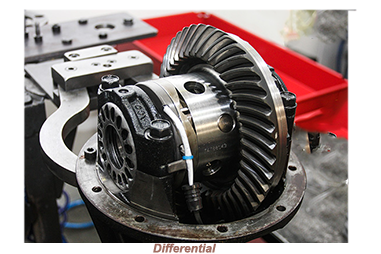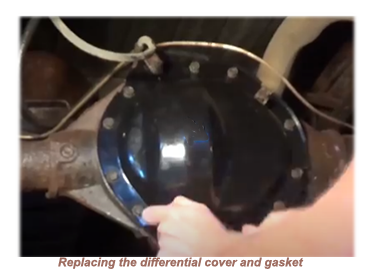
 Maintaining the differential on a classic car is an important part of keeping the vehicle in good running condition. The differential is responsible for distributing power from the engine to the wheels, and if it's not properly maintained, it can lead to serious problems.
Maintaining the differential on a classic car is an important part of keeping the vehicle in good running condition. The differential is responsible for distributing power from the engine to the wheels, and if it's not properly maintained, it can lead to serious problems.
The design of differentials can be classified into three main categories, as follows

It is essential to maintain the differential of a classic car to ensure that the vehicle performs optimally and lasts longer. The differential is an essential part of a vehicle's drivetrain system, which plays a vital role in transferring power from the engine to the wheels. Failure to perform regular maintenance on the differential can lead to significant problems.
 The differential is a mechanical component that enables the wheels of a vehicle to rotate at varying speeds while ensuring that power and torque are distributed evenly to each wheel.
The differential is a mechanical component that enables the wheels of a vehicle to rotate at varying speeds while ensuring that power and torque are distributed evenly to each wheel.
The front differential is an integral part of a vehicle's drivetrain system responsible for transmitting power from the gearbox to the front wheels. Differential is a crucial component in a vehicle's drivetrain that enables the wheels to rotate at varying speeds, which is essential for executing turns and ensuring optimal road grip.
Front-wheel-drive (FWD) vehicles usually have their differential located next to the gearbox in a common housing. The term commonly used to describe this integrated unit is transaxle.
The rear differential is an essential mechanical component situated on the rear axle of a vehicle. Its primary function is to distribute power to the wheels, enabling them to rotate at different speeds while maintaining traction on the road. The vehicle's power is transferred from the engine to the wheels via a system of gears. The differential is a crucial component in a vehicle's drivetrain that enables the wheels to rotate at varying speeds, a necessary function when turning. In automobiles that employ rear-wheel-drive (RWD), the differential is commonly situated between the two rear wheels and is connected to the gearbox through a driveshaft. Automobiles that come with all-wheel-drive (AWD) or four-wheel-drive (4WD) are equipped with a centre differential or transfer case that allows for the allocation of power between the front and rear wheels.

![]() Regularly check the differential fluid level and condition. If the fluid is dirty or low, it will need to be changed.
Regularly check the differential fluid level and condition. If the fluid is dirty or low, it will need to be changed.
To check differential fluid levels, simply insert a long thing screwdriver into the open port. If the tip of the screwdriver comes into contact with gear oil it’s a sure sign by that sufficient fluid is present. Gingerly remove the screwdriver and check the quality of the differential fluid. If it is cloudy or contains small particles it is time to drain and replace the fluid.
![]() Inspect the differential for any signs of leaks. Any leaks should be repaired as soon as possible. Any vehicle with a damaged or leaking differential should not be driven on the open road.
Inspect the differential for any signs of leaks. Any leaks should be repaired as soon as possible. Any vehicle with a damaged or leaking differential should not be driven on the open road.
![]() Inspect the differential gears for any signs of wear or damage. If the gears are worn or damaged, they will need to be replaced. It is recommended to inspect the gears while the differential cover is off when replacing the differential fluid. The gears are extremely exact, and any misalignment will cause the entire system to fail. Inspecting the differential gears for wear can help you diagnose a variety of rear-end noise with one of the most prevalent reasons of rear differential noise is misaligned gears.
Inspect the differential gears for any signs of wear or damage. If the gears are worn or damaged, they will need to be replaced. It is recommended to inspect the gears while the differential cover is off when replacing the differential fluid. The gears are extremely exact, and any misalignment will cause the entire system to fail. Inspecting the differential gears for wear can help you diagnose a variety of rear-end noise with one of the most prevalent reasons of rear differential noise is misaligned gears.
The rear differential is made up of numerous gears with intertwined teeth. The precision with which these gears are organised and orientated relative to each other determines the effectiveness of its function. If, for example, the mechanism's oil runs low or the gear arrangement shifts, rear differential noise occurs. Vehicle owners should be concerned about common rear differential noises such as gear whine, bearing noise, and clunking.
![]() A differential contains three types of bearings: pinion bearings, carrier bearings, and spider gear bearings.
A differential contains three types of bearings: pinion bearings, carrier bearings, and spider gear bearings.
Prying the rear of the driveshaft back and forth and measuring the lateral displacement can be used to diagnose the health of the pinion bearings (there are two). If it is more than a few thousands of an inch at the pinion seal, the bearings are most likely nearing the end of their useful life.
 The carrier bearings (two) and spider gear bearings (two to four) are much less likely to fail and are more difficult to detect without removing the differential. If there is noise from the differential and the pinion bearings are fine, the carrier bearing(s) are most likely faulty. The only way to be certain of poor carrier bearings is to open the differential and inspect them.
The carrier bearings (two) and spider gear bearings (two to four) are much less likely to fail and are more difficult to detect without removing the differential. If there is noise from the differential and the pinion bearings are fine, the carrier bearing(s) are most likely faulty. The only way to be certain of poor carrier bearings is to open the differential and inspect them.
Metal particles in the differential lubricant indicate that the bearings are deteriorating.
![]() Inspect the differential cover for any signs of damage or leaks. If the cover is damaged, it should be replaced.
Inspect the differential cover for any signs of damage or leaks. If the cover is damaged, it should be replaced.

![]() Inspect the drive shaft and U-joints for any signs of wear or damage. If either part is showing signs of being worn or damaged, they should be repaired or replaced.
Inspect the drive shaft and U-joints for any signs of wear or damage. If either part is showing signs of being worn or damaged, they should be repaired or replaced.
![]() Inspect the differential bushings for any signs of wear or damage.
Inspect the differential bushings for any signs of wear or damage.
 Hearing a clunking noise or feeling a shock when accelerating or transferring gears from drive to reverse is an indication that this bushing is no longer operating at anywhere its maximum capacity.
Hearing a clunking noise or feeling a shock when accelerating or transferring gears from drive to reverse is an indication that this bushing is no longer operating at anywhere its maximum capacity.
If the bushings are worn or damaged, they should be replaced.
Classic cars may require special attention and care. In cases of uncertaintly, the owner's manual should be consulted for specific information and guidance on how to maintain a particular vehicle.
ub4




